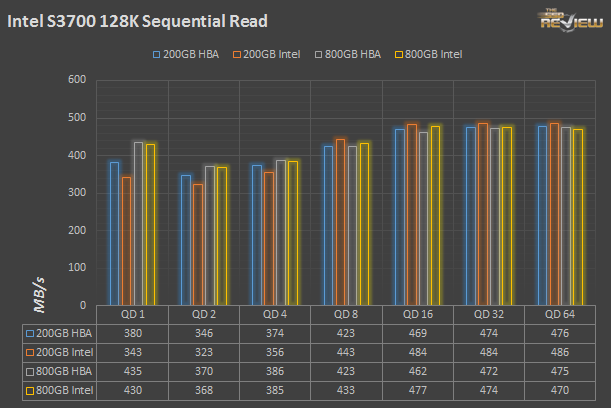MEASURING PERFORMANCE
We’re doing something a little different this time. Normally, we’d only use a Host Bus Adapter for benching SATA drives. Using Intel or AMD SATA ports can lead to inconsistent results across driver revisions, and in the enterprise space, most SATA drives are indeed connected via HBA. In the Intel DC S3700 SSDs case, looking at some numbers from both can help explain some of the performance specifics.
Each drive was securely erased prior to testing.
The differences in sequential reads is quite small, both between the two capacities and the two storage controllers. The S3700 peaks near 475 MB/s.
With four times the flash, the 800GB clearly outclasses the smaller Intel in sequential writes by as much as 80MB/s. The 200GB maxes out at 384MB/s, while the 800GB reels in over 460MB/s. This represents the single largest difference in performance, but is unlikely to be as relevant in enterprise workloads.
The S3700 line purportedly can sustain better than 75,000 4K random read IOPS. In trying to understand how that number was reached, we have to look at both SSDs attached to our motherboard’s 6gbps ports and dangling off our test rig’s LSI 9207-8i HBA.
The difference is readily apparent. Both S3700 SSDs are essentially the same in terms of random read performance, but far more IOPS are on tap when running off the motherboard’s ports – over 15,000 more. On the HBA, both drives stop scaling much past QD 4, peaking just north of 73,000 IOs per second. When we skip the HBA though, more than 88K IOPS can be reached. At the end of the day when Intel states that the DC S3700 can better 75,000 random read IOPS, this appears to be what they mean. You can expect to get those 75K, but under certain circumstances, more transactions per second realized.
The same discrepancy is found with 4K random write performance as well, just in a less noticeable manner. We’re just looking at fresh-out-of-the-box numbers here (we’ll look at steady state write performance later), but both drives can exceed 60,000 4K random write IOPS when fresh. On the HBA however, 56,000 is about the max. It won’t take long under a write intensive workload to beat that number down to steady state, and that is where Intel derives the 3700’s 4K write numbers from.
When attached to the HBA, higher QD random performance just gets attenuated a bit on the high end.
 The SSD Review The Worlds Dedicated SSD Education and Review Resource |
The SSD Review The Worlds Dedicated SSD Education and Review Resource | 


Awesome product again, but price is very strange its equal to capacity i mean 2x100GB is exactly the same as 1x200GB and so on. For enterprise server more capacity is logical (save power & room), but for mid range servers its a kill – deal to buy smaller drives price/performance it will be a lot more then awesome.
Are you still using IOMeter to generate you test data? Also, are you testing the drive raw, or with a logical file system? Great review!!
On page 5, it’s described that this SSD uses deduplication.. is it right? Because I don’t find Intel has mentioned it elsewhere.. thanks for the great review.